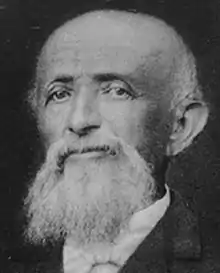Alessandro Rossi | |
|---|---|
 | |
| Born | 21 November 1819 |
| Died | 28 February 1898 |
| Occupation | Entrepreneur |
| Position held | member of the Chamber of Deputies of the Kingdom of Italy (1865–1867), member of the Chamber of Deputies of the Kingdom of Italy (1867–1870) |
.jpg.webp)
Alessandro Rossi (21 November 1819 in Schio – 28 February 1898 in Santorso) was an Italian textile industrialist and politician. He introduced technological innovation for manufacturing wool in Schio, Veneto. He inherited the wool mill Lanificio Rossi from his father Francesco Rossi, and converted the company into one of the main industries of Italy. He was deputy and senator of the Kingdom of Italy.
Biography
Alessandro Rossi was the son of the Italian wool manufacturer Francesco Rossi,[1] who founded Lanificio Rossi in 1817. Between 1845 and 1898, Alessandro Rossi developed and grew the company; by the 1880s the company was the largest in Italy, with 5,000 employees.[1]
Before taking over Lanificio Rossi, Alessandro Rossi visited advanced factories in England and France. When he became the chief of the family firm in 1845, he renewed the machinery of the wool mill, increasing its production capacity.[2]
Alessandro Rossi inherited the mill Francesco Rossi and built other factories, such as the six-storey building La Fabbrica Alta, designed by Belgian architect Auguste Vivroux and built between 1861 and 1862. He was inspired by the ideas of Robert Owen and Sir Titus Salt and built a worker's colony called New Schio.[3] For Rossi, it was important to give workers a sense of personalization. He created aid associations, houses, schools, kindergartens, and shares in the company profits.[2]
Rossi overcame the depression of the 1870s establishing a system of autonomous managements, dividing his company into four divisions forbidden to compete internally and with a board of directors concentrated in Milan.[2]
In 1873, Rossi founded the "Consorzio della Fabbrica della Carta" (Paper Factory Consortium) in Arsiero.[4] In 1878, he established a technical school in Vicenza. He also promoted the first hydroelectric plants in Italy, as they were a cheaper source than imported coal.[5] He stimulated the creation of the Mechanical and Metallurgical Workers Assembly.[6]
In 1892, Rossi resigned as President of his company and he dedicated to politic activities.
Support to protectionism in Parliament
In 1866, Alessandro Rossi was elected to Parliament. Four years later, he was elected as Senator. In 1876, he passed from a free trader to a representative of industrial protectionism. In 1870, Rossi was commissioned by the Council of Industry Trade for an official inquiry into Italian competitiveness. In 1874, he concluded that manufacturers needed state protection, recommending tax relief and custom duties.[6]
Such as Souther agricultures, silk manufacturers, and Tuscan banks opposed to Rossi's propositions, he supported the creation of the Italian Cotton Association and the Mechanical and Metallurgical Workers Assembly. In this way, he was available to create the first bloc of business interests with brewers, leather workers, and silk and paper manufacturers.[6]
Rossi won public support through newspapers that he owned. However, he was outnumbered in Parliament. From five hundred deputies, just fifteen defended business interests and just three were manufacturers.[6]
In 1876, Rossi fought Prime Minister Agostino Depretis' attempts of reducing tariffs and protectionism. Rossi hound Depretis' government through the media until he accepted to help the industry. Depretis firmed a treaty with France, but the treaty didn't reach the protectionism that Rossi sought.[6]
By the late 1880s, Rossi supported a broader protectionist initiative, promoting protection for agriculture of Russia and American grains. In 1887, he defended a new general tariff arguing that France needed Italy exports. He achieved broad support and Parliament passed a protectionist general tariff.[6]
Ideas
Rossi was opposed to state intervention in economic life.[7] He was a leader in the industrialization of Italy after the unification and proposed a model for other industrialists.[1] However, he defended protectionist measures,[5] such as the establishment of high duties,[7] between the 1870s and 1880s.[2] In 1882, he promoted a political project that called for an alliance between industrialists, workers, and radical intellectuals to support stronger custom protections.[5]
Buildings in Schio
Rossi commissioned or founded some of the most iconic places and monuments in Schio, such as Asilo Infanzia Alessandro Rossi for the worker's children, Monumeto al Tessitore, and Quartiere Operaio La Nuova Schio.[8]
References
- 1 2 3 Fontana, Giovanni Luigi; Riello, Giorgio (November 2005). "Seamless Industrialization: The Lanificio Rossi and the Modernization of the Wool Textile Industry in Nineteenth-Century Italy". Textile History. 36 (2): 168–195. doi:10.1179/004049605x61555. ISSN 0040-4969. S2CID 154943058.
- 1 2 3 4 Amatori, Franco (1980). "Entrepreneurial Typologies in the History of Industrial Italy (1880–1960)". Business History Review. 54 (3): 359–386. doi:10.2307/3114244. ISSN 2044-768X. JSTOR 3114244. S2CID 155625234.
- ↑ "The Schio & Vincentino Open Air Museum of Industrial Archaeology – ERIH". www.erih.net (in German). Retrieved 2021-03-31.
- ↑ "The Company - Nuova Cartiera Rossi". www.nuovacartierarossi.it. Retrieved 2021-03-31.
- 1 2 3 Favero, G. (2011-06-01). "Business Attitudes Toward Statistical Investigation in Late Nineteenth Century Italy: A Wool Industrialist from Reticence to Influence". Enterprise and Society. 12 (2): 265–316. doi:10.1093/es/khq141. ISSN 1467-2227.
- 1 2 3 4 5 6 Samuels, Richard J. (2003). Machiavelli's children : leaders and their legacies in Italy and Japan. Ithaca: Cornell University Press. ISBN 0-8014-3492-0. OCLC 50630508.
- 1 2 Coppa, Frank J. (1970). "Economic and Ethical Liberalism in Conflict: The Extraordinary Liberalism of Giovanni Giolitti". The Journal of Modern History. 42 (2): 191–215. doi:10.1086/240549. ISSN 0022-2801. JSTOR 1905941. S2CID 153348761.
- ↑ "Industrial Archeology - Visit Schio". www.visitschio.it. Retrieved 2021-03-31.